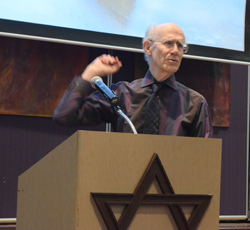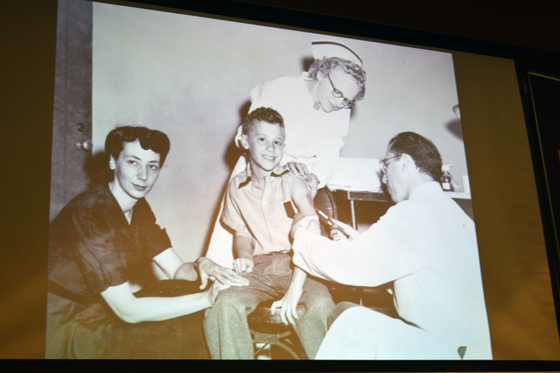Had he lived, today, Monday October 28th, would have been Jonas Salk’s 105th birthday. Last night, an audience of mostly senior citizens remembered and appreciated the enormity of the contribution that he made to world health by developing the polio vaccine. And, indirectly, the man who was the speaker at Tifereth Israel Synagogue—Salk’s son, Dr. Peter Salk, MD—played an important role in that drama while he was still a child.
In a slide show about his father, Peter Salk showed a photograph of himself as a boy receiving a polio vaccine shot as his mother Donna and father sat on either side of him. It was a publicity photograph to show that Jonas Salk was so confident in the vaccine that he was willing to give it to his own children – Peter being the oldest child, followed by Darrell and Jonathan.

The scene was real, in that Peter indeed received the shot, but it also was staged in that Peter actually dreaded needles, and his very big smile in that photograph was a case of very brave acting.
“I hated shots,” Peter confided. His brother would hide, and “had to be dragged out from under the bed. But for some reason, the needle missed a nerve. It didn’t hurt. So I was grateful.”
Barbara Sperling, a member of the Conservative congregation, said she remembered very well that Peter, who was a contemporary, had been vaccinated because her mother told her that if Dr. Salk was willing to inoculate his own children, then she was willing to let Barbara be vaccinated too.
After that photo session, another 5,000 students were inoculated in a test study.
Elaine Gale, another member of the congregation, remembered being inoculated at home, while sitting in her kitchen.
When that test was deemed successful, 1.8 million school children were included in a field trial, during which 443,000 received innoculations of polio vaccine, 210,000 received a placebo, and 1.2 million, as “observed controls” received neither placebo nor vaccine. When that trial also was successful, a general program of vaccination was taken across the country.
Today 74 years of age, I remembered being among the millions of school children who received the vaccine after the trials. My wife Nancy, 71, remembered receiving both the shot and later swallowing the rival sugar cube vaccine treatment created by Dr. Albert Sabin, who was older and more established in scientific circles than Salk. So bitter was Sabin about Salk that some believe he blackballed Salk from the National Academy of Sciences. Salk was also denied the Nobel Prize for which he was nominated — perhaps because three other scientists had previously received the award for their work on how to grow polio virus in a tissue culture.
Peter Salk said his father quipped that it didn’t matter that he never received a Nobel Prize because “everyone thought I did.”
In essence, the dispute between Salk and Sabin was whether the virus should be “inactivated” before being administered to patients, as Salk believed, or simply weakened, but still alive, as Sabin believed.
During his slide presentation, Peter Salk projected graphs illustrating the time line of polio’s disappearance from the U.S. According to the famous scientist’s son, a 97 percent drop in the rate of polio in the U.S. occurred in the first seven years following Salk’s introduction of the inactivated virus and only the last 3 percent of the decline toward the virus’s ultimate elimination occurred following introduction of Sabin’s live vaccine.
Sabin’s vaccine, which was infused into sugar cubes, was touted as being more effective than Salk’s and longer lasting. For a while, the sugar cubes were far more popular because they were less intimidating for patients and less costly to administer. Unfortunately, the weakened viruses could in some cases mutate in the intestinal tract to a fully virulent form that could cause paralysis. There was no such problem when the virus was inactivated.
In 1952, when many members of the Tifereth Israel audience were children, there had been an outbreak of polio in the United States that had caused more than 20,000 people to be crippled and more than 3,000 killed. I was 7 years old at the time, and I still remember how parents were afraid to allow their children to go to public swimming pools, or other crowded places, lest we encounter the virus.
Contrast our memories of a nationwide epidemic—and ensuing panic — with what Peter Salk said is one of the reasons why the anti-vaccination movement has gained so many adherents. “Today, people are losing sight of the importance of vaccines,” he said. “Part of the problem is the success of vaccines. People are not faced with the kinds of infectious disease issues we were in my lifetime.”
When Salk’s polio vaccine was declared a success, he became a national hero. In the popular mind, he was the Albert Einstein of medicine. Many of his scientific colleagues became jealous of Salk’s name becoming a household word. While they were pleased his fame could help bring about financing for research—as evidenced by the world famous Salk Institute for Biological Studies in La Jolla, which he planned with the world-famous architect Louis Kahn—many privately derided his credentials as a scientist.
Peter Salk said that the Jonas Salk Legacy Foundation, of which he is president, is participating with Rady Children’s Hospital in putting together an educational module for use in the schools explaining why vaccinations work. Part of the package is the documentary The Shot Felt Around the World, a portion of which Peter Salk screened at the event sponsored by the Tifereth Israel Men’s Club.
Additionally, he said, the Foundation hopes to cull through his papers and documents and to continue his work not only in disease prevention but also in promoting cooperation and peaceful relations among nations.
Republished from San Diego Jewish World


























